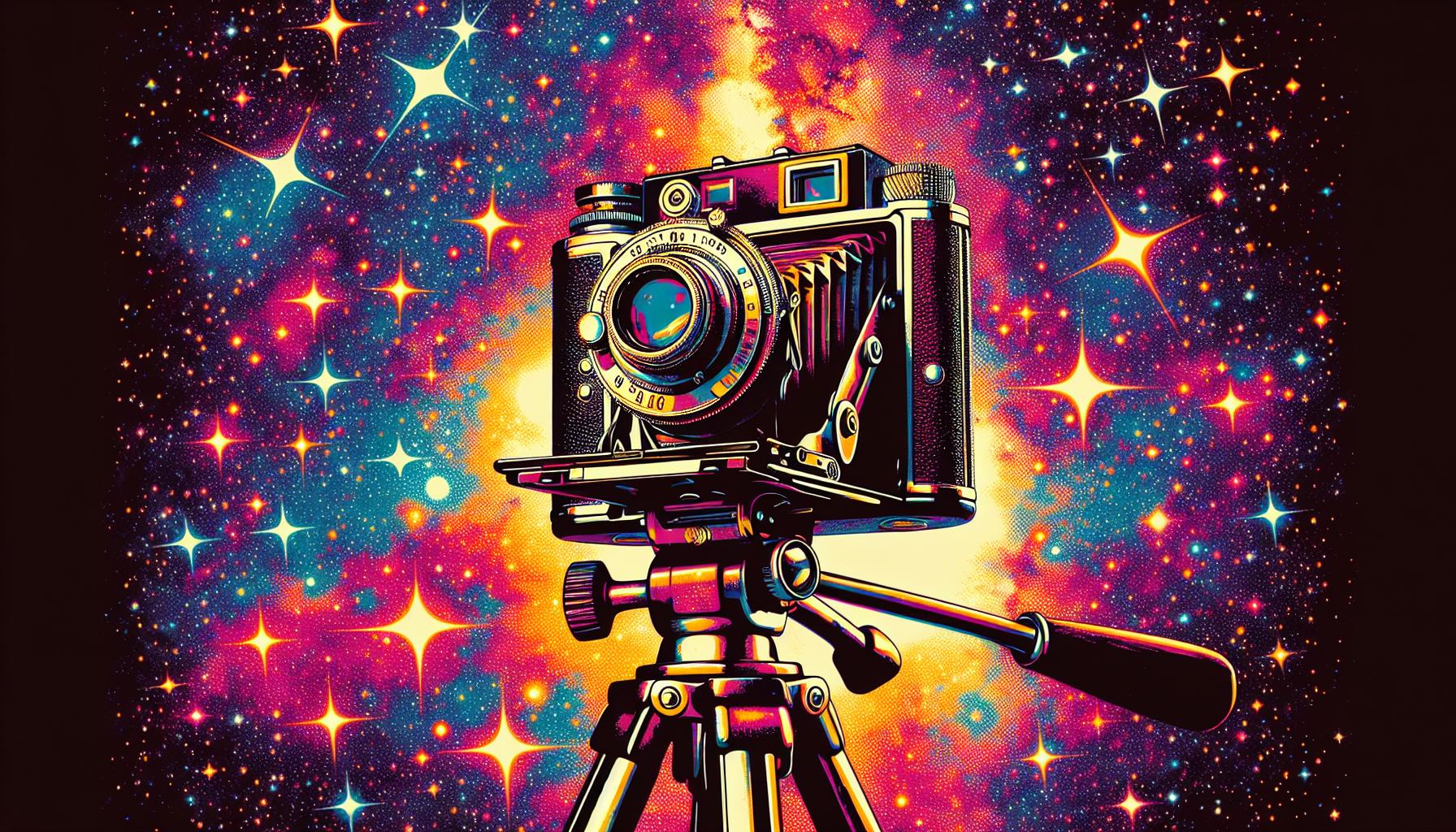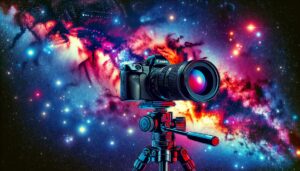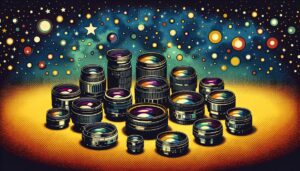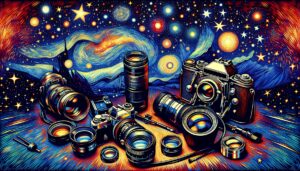This site contains affiliate links to products. I may receive a commission for purchases made through these links.
If you’re like me, you’ve probably spent countless nights staring up at the sky, captivated by the beauty of the stars. But capturing that beauty in a photograph? That’s a whole different ball game. That’s where astrophotography comes in, and the Canon M50 is a fantastic choice for this pursuit.
Astrophotography might seem like a daunting task, but with the right equipment, it’s easier than you might think. The Canon M50, with its impressive features and user-friendly interface, is a game-changer. I’ve found it to be a reliable companion on my astrophotography adventures.
Whether you’re a seasoned photographer or just starting out, the Canon M50 is a great tool to have in your arsenal. It’s not just about the gear, though. It’s about the thrill of capturing something as vast and beautiful as the night sky. And trust me, there’s nothing quite like it.
Choosing the Right Camera for Astrophotography
When I first delved into astrophotography, I had my fair share of hitches. Picking up the best-suited camera was a crucial and intricate decision. Points like durability, ease of use, pricing, and image quality were factors I couldn’t ignore.
That was when Canon M50 found its way onto my radar. It’s a compact, mirrorless camera that packs a punch without straining your budget. Its versatility suits beginners and seasoned photographers alike, making it a smart choice for those looking to explore the art of capturing the night sky.
Canon M50’s extensive range and superior image stability simplify astrophotography. Its impressive 24.1-megapixel APS-C CMOS sensor is the game-changer. I was astounded by the truly awe-inspiring images the camera could snap, impeccable in terms of color rendition and detail capturing. Even in low-light situations, the output was crisp and pleasing to the eye.
However, choosing a camera isn’t all about the specs – usability matters too. You’re in for a treat with Canon M50’s user-friendly interface. The camera doesn’t swamp you with complicated settings. Instead, its Auto Lighting Optimizer adjusts brightness and contrast on the fly, ensuring every photo reaches its maximum potential.
Equipped with a sharp and responsive electronic viewfinder, it delivers live exposure previews. It’s got a nifty feature called Focus Peaking, highlighting the in-focus areas of your image – a godsend for manual focus enthusiasts like me in astrophotography!
Taking into account these factors, it became clear to me that the Canon M50 had a well-rounded offering that was hard to beat. It’s a fine balance of user-friendliness, sensible pricing, and stellar performance.
And thus, the Canon M50 seamlessly integrated itself into my astrophotography journey, leaving me free to explore the infinite beauty of the night sky, one photo at a time. There will always be more celestial bodies to photograph and galaxies to explore. And believe me, astrophotography will never stop presenting its unique challenges – but with the Canon M50, you’re well-equipped to face them.
Introducing the Canon M50
With a strong focus on astrophotography, we simply can’t overlook the Canon M50. A camera that has been my companion through countless midnight star-gazing sessions, the M50 is something I’ve grown quite fond of. If you’re considering dabbling in astrophotography, the versatility of the Canon M50 will surely surprise you.
What’s fascinating about this particular camera is its ability to cater to both beginners and seasoned photographers alike. Its user-friendly interface allows novice photographers to easily navigate and adjust settings without feeling overwhelmed. On the other hand, the M50 offers enough flexibility for the more experienced photographers to fine-tune their shots, thanks to its comprehensive manual mode.
Let’s talk about image quality. Picture this: It’s a clear night, you’re surrounded by silence, and as you look up, you find a sky adorned with numerous twinkling stars. You pull out your Canon M50, point it towards the sky, and click the shutter. The result? Crystal clear images that truly capture the mystique of the night sky, all thanks to the M50’s exceptional image sensor.
To back that up, here are some key specifications of the Canon M50:
| M50 Features | Description |
|---|---|
| Sensor Type | APS-C CMOS |
| Megapixels | 24.1MP |
| Image processor | DIGIC 8 |
| ISO range | 100-25600 |
| Shutter speed | 1/4000 to 30 sec |
Impressive, isn’t it? But it’s not just about the specs. It’s about how the Canon M50 makes astrophotography accessible to everyone. It skillfully blends usability, pricing, and performance, thereby emerging as a formidable contender in the realm of astrophotography.
And remember, photography, much like any art, is subjective. The best camera is truly the one that allows you to better express your creativity, and for me, that’s the Canon M50. The journey we share with our gear is a personal one, be it capturing the grandeur of nebulae or the delicate strands of a fading galaxy. And in my journey of astrophotography, the Canon M50 has been nothing short of a reliable partner.
Key Features of the Canon M50 for Astrophotography
As an avid astrophotographer, I find the Canon M50’s versatility stands out against other cameras. The interchangeable lenses mean you can swap out for a wide-angle or super-telephoto lens, perfect for capturing the grandeur of the night sky or honing in on a specific celestial body.
The image quality is outstanding, delivering phenomenal resolution even in low-light conditions. The powerful DIGIC 8 image processor and 24.1-megapixel sensor combine to produce crystal clear images with minimal noise — a crucial factor in astrophotography.
The user-friendly interface is another significant benefit. Whether you’re a beginner or a well-experienced astrophotographer, you’ll grasp the camera’s functions easily. Switching between various shooting modes, adjusting the ISO, or even changing the shutter speed, the Canon M50 doesn’t make it complicated.
Let’s have look at the key specifications of Canon M50 which are essential for astrophotography:
| Specifications | Canon M50 |
|---|---|
| Sensor type | APS-C (22.3 x 14.9 mm) CMOS |
| Image processor | DIGIC 8 |
| Megapixels | 24.1 |
| ISO range | 100-25600 |
| Shutter speed | 1/4000 to 30 sec |
These specifications underpin the Canon M50’s excellent performance in astrophotography. The large ISO range gives you the flexibility to shoot in a variety of lighting conditions. The APS-C sensor, well renowned for its performance in low light, captures every tiny detail that our Milky Way flaunts.
While the Canon M50 has numerous features suited to astrophotography, its well-roundedness extends beyond this sphere. It caters to different styles of photography without missing a beat, reflecting a balance of pricing, usability, and performance.
In the realms of astrophotography, the Canon M50 is more than just a camera. It’s an accessible, reliable partner that brings the cosmos closer. Whether you’re embarking on a beginner’s journey or looking to up your game, this camera gives you access to the stars.
Tips and Techniques for Astrophotography with the Canon M50
As we dive deeper into the heart of astrophotography with the Canon M50, let’s discuss the tips and techniques that I’ve found useful in capturing the beauty of the night sky.
When using the Canon M50 for astrophotography, it’s important to set the camera to its highest possible ISO setting. The EOS M50’s sensor has what it takes to produce less grain on higher ISO settings than other cameras. Remember, higher ISO settings ensure your camera can capture enough light, especially critical in low-light situations like night sky imaging.
Another valuable tip to enhance your astrophotography experience is to make good use of the Canon M50’s Bulb mode. This allows for long exposure times beyond the 30 seconds limit of manual mode, enabling the camera to pick up faint galaxies and nebulae in the night sky.
Autofocus can sometimes be a hindrance when focusing on stars, but not with Canon M50’s Manual Focus Peaking. It highlights the areas of highest contrast (and therefore in-focus) in your chosen color making it easier to manually focus on the stars.
I also recommend taking advantage of Canon’s Image Stabilization technology. Although it’s more commonly used to reduce camera shake during handheld photography, it also comes in handy for astrophotography. When mounted on a tripod and aimed at the sky, it becomes more about maintaining the sharpness of stars, countering the earth’s rotation.
Mastering these tips and techniques will not magically transform you into an astrophotographer – but if you’re shooting with your Canon M50, it can certainly get you a lot closer. The key is to practise and experiment until you find the settings that work best for your stargazing adventure.
And beyond camera settings and gear, budding astrophotographers need to consider environmental factors. Clear skies, low light pollution, and strategic timing can do wonders to enhance your celestial captures. But we’ll delve deeper into these factors in the forthcoming sections.
Showcasing the Results: Stunning Astrophotography with the Canon M50
Once you’ve grasped the camera settings for shooting stellar bodies in the night sky, it’s time to marvel at what the Canon M50 can deliver. From stunning star trails to the clear, crisp image of the Milky Way, the Canon M50’s results truly push the bar high for astrophotography.
The end results will speak for themselves – from detailed light captured from distant stars to vivid galaxy hues. I remember my first photo of the night sky with the Canon M50. The entire frame was filled with a vibrant mix of constellations, nebulas, and the occasional meteor streak. The camera’s mirrorless design, coupled with Image Stabilization, came through on every shot, delivering near-perfect results.
Another standout feature in reviewing images was the camera’s ability to perform admirably even in low-light conditions. I was able to capture breathtaking images of the night sky without noise interfering with the crispness of the stars or the milky way.
You may wonder how different each shot can be. Each star, each constellation, every astral body presents a unique photography opportunity. No two nights of sky photography will ever be identical with the Canon M50. Whether it’s shooting a spectacular meteor shower, a radiant moon against a star-studded background, or a star trail image drawn with the Earth’s rotation, it’s about flexibility and creativity.
Astrophotography is as much an art as it is a science, and with the right equipment, you can achieve impressive results. I’ve seen it firsthand with the Canon M50. My collections of celestial photographs, taken with the Canon M50, are a testament to the camera’s capabilities.
Finally, remember that photography, astrophotography included, is not just about the gear. It’s about the moments, the experiences, and the stories that come out of those moments. The Canon M50 happens to be a tool that’s excellently suited to capturing these night sky stories. From a casual stargazer to the professional nightscape photographer, Canon M50 makes astrophotography accessible.
However, the camera alone won’t do all the magic. It’s the knowledge of how to bring out the best from it that makes the difference. And I’m here to share those insights with you – because every night sky story deserves to be told.
Conclusion
So, there you have it. The Canon M50 shines as a fantastic choice for astrophotography. Its versatility, high-quality imaging, and user-friendly interface make it a star among cameras. It’s not just about the specs, though they are impressive. It’s the balance of usability, cost, and performance that sets it apart. The mirrorless design, image stabilization, and low-light capabilities allow you to capture the night sky in stunning detail. But remember, it’s not just the camera. Your skills and creativity are also key in bringing those celestial stories to life. So, grab your Canon M50, aim for the stars, and let the universe be your canvas.
Frequently Asked Questions
Q: Is the Canon M50 good for astrophotography?
The Canon M50 is excellent for astrophotography, offering a versatile, user-friendly interface, and superior image quality. Whether you’re aiming to capture distant stars or vivid galaxy hues, the M50’s performance is commendable.
Q: What features make the Canon M50 suitable for astrophotography?
Key features such as the camera’s mirrorless design, inbuilt image stabilization, and ability to perform well in low-light conditions make the Canon M50 suitable for astrophotography.
Q: What are the key specifications of the Canon M50?
Key specifications include its sensor type, megapixels, image processor, ISO range, and shutter speed. These contribute significantly to its image quality and versatile utility.
Q: Can the Canon M50 deliver good results in low-light conditions?
Yes, one of the strengths of the Canon M50 lies in its ability to perform well in low-light conditions, making it a great instrument for astrophotography.
Q: Is the Canon M50 a beginner-friendly option for astrophotography?
Certainly, the Canon M50 boasts a well-rounded, user-friendly interface making it a perfect option for beginners in astrophotography.
Q: Does knowledge and skill play a role in using the Canon M50 for astrophotography?
Indeed, while the Canon M50 is a robust tool for capturing night sky stories, having the knowledge and skill to maximize its features is crucial for achieving the best results.




